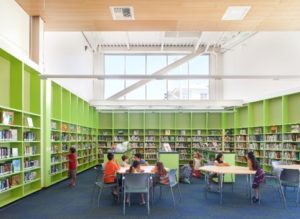For more than 25 years, New Buildings Institute (NBI) has worked collaboratively with industry market actors to promote advanced design practices, innovative technologies, public policies, and programs that improve energy efficiency and reduce emissions from the built environment. Our collective work helped spark broad coalitions that are advancing game-changing technologies such as heat pump water heaters, metrics for grid-interactive buildings of the future, climate-aligned building codes, carbon neutral, resilient school buildings, low-carbon financing specifications, and much more.

As we look toward the future, we’re squarely focused on ensuring buildings play a key role in keeping global temperature rise to less than 1.5 degrees Celsius above pre-industrial levels by 2030. To avert the worst effects of climate change, our total emissions must be cut in half by 2030. This fundamental shift requires that all industries using energy to operate their buildings and manufacture and transport goods make significant changes—and quickly, according to the Intergovernmental Panel on Climate Change.
Earlier this month, we saw the passage of the Inflation Reduction Act which brings an unprecedented $369 billion to accelerate our transition to a clean energy economy. This critical investment is just what is needed right now to meet the imperative for speed and scale to address the climate crisis. Provisions include critical adoption of codes and standards with zero energy goals, which NBI has been pressing for more than a decade. The legislation also seeks to prioritize frontline communities, who have borne the brunt of poor air quality from nearby power production and missed out on past efficiency investments.
For NBI, equitable, clean, and resilient buildings and communities are part of a critical path for addressing climate change. We have our work cut out for us. But looking back on the progress we have made alongside our partners and clients over the last 25 years gives us optimism for the future.
Maintaining our focus on efficiency first
As was the case at our founding, energy efficiency is still the lowest cost energy resource. NBI’s work has resulted in decades of creating cutting-edge resources for design teams and building owners, who benefit from lower utility bills, reduced maintenance costs, and improved health and comfort. As pressure mounts to consider the energy burden of disadvantaged communities and the carbon footprint of buildings, model energy codes and building performance standards development will remain a key priority of our codes and policy work.
We are helping leading jurisdictions develop building performance standards (BPS), stretch codes, and policies—particularly policies that ensure low-income energy customers are not left with higher energy bills as the industry transitions. We are accelerating significant carbon and energy bill savings for both new construction and existing buildings by influencing building codes and policies through the Codes for Climate Initiative. Launched in 2021, Codes for Climate will continue to support national model code and policy advancement, while providing achievable pathways for states and cities seeking to adopt climate-aligned codes that lead to higher performing, low-carbon buildings. If we adopted just one Codes for Climate recommendation, such as mandating heat pump water heaters, that could save nearly 100 million tons in carbon emissions every year.
Leveraging buildings as grid assets
As we strive for net zero achievement in commercial and residential buildings—both for better equity outcomes and building decarbonization, buildings can also be assets for utilities that are managing a shift to a 100% renewable energy grid. Buildings have the potential to act as virtual power plants, either reducing the need for electricity or supplying clean energy during times of peak demand.

“Behind-the-meter” distributed energy resources (DERs) such as rooftop solar, electric vehicle (EV) batteries, and thermal storage, as well as thermostats and appliances with “smart” controls, can be an asset to grid managers. They enable buildings to shed and shift demand at opportune times to reduce peak demand, optimizing energy and carbon reductons. Such grid-interactive building measures could save the U.S. power system between $100 to 200 billion over the next 20 years, according to the U.S. Department of Energy (DOE). In addition, the measures would cut CO2 emissions by 80 million tons per year by 2030, the equivalent of shutting down 20 coal-fired power plants.
Our GridOptimal® Buildings Initiative, developed in partnership with the U.S. Green Building Council, has devised eight key metrics defining building-grid friendliness that are already being piloted by designers and by utilities. In addition to providing demand flexibility, more widespread adoption of those metrics will help eliminate the need to fire up fossil fuel plants that burden nearby communities with air pollution.
Leveraging buildings to improve public health outcomes

The way we design, build, operate, and renovate our buildings and communities has significant ramifications for the health and well-being of all members of our society. Inequities in our public health system were spotlighted during the global pandemic and record summer temperatures. We must do more to make building and community design part of the solution and we are starting to see that vision realized. Young people in particular are demanding change starting with where they spend most of their days. This has sparked our Getting to Zero Schools Initiative to grow dramatically over the last two years. As more schools set zero energy and carbon neutral goals, NBI will continue to provide convening, facilitation, and technical support.
And we know we need to go beyond brick-and-mortar buildings, and even beyond the grid. When developing codes, policies, and programs, we are looking at ways buildings can couple efficiency and resiliency measures to reduce urban heat islands, provide shade, and serve as places to gather and find refuge in the event of a power outage.
Healthy buildings as centers for economic prosperity
The culmination of market forces, federal and state-led policies, and technological innovations will result in billions of dollars of investment in healthier, resilient buildings. But the true promise of this economic transformation is the opportunity to provide equitable economic opportunity, employment, and wealth creation for all members of our society now and for future generations.

The Justice 40 Initiative, along with many state and local programs, are incentivizing workforce development programs and pathways to employment that create opportunities to develop intergenerational wealth for Black, Indigenous, and people of color (BIPOC) community members. Our Next Gen program, a professional development program that prioritizes students of color, connects a new generation of emerging industry professionals to mentors and networks, while providing education and training to advance their knowledge and careers. New financial tools, including PACE funding for low-carbon buildings and the Securities and Exchange Commission’s move to set standards for environmental, social, and governance factors, will help cement these objectives and approaches.
The future is now
The future we seek is a lofty ambition, but now more than ever, is within reach. While our ambitions are high, our experienced team of 34 passionate professionals recognize the only way to achieve the impacts we strive for is through ongoing partnerships and collaboration. These values are at the heart of everything we do.
The future we seek is one that ensures all people experience the benefits of low carbon, energy efficient, healthy, and resilient buildings and communities. These translate to reduced financial burden through lower energy bills and healthier, more comfortable places for people to live, study, work, and play. We hope you share that ambition and will join us. Whether gathering in Minneapolis for the 2023 Getting to Zero Forum, collaborating on a Getting to Zero roadmap for your school district, partnering on a stretch code for your city, or registering for one of many free webinars offered throughout the year, we look forward to seeing you there!
by Ralph DiNola, CEO, New Buildings Institute
Did you enjoy this content? Consider supporting NBI’s work with a donation today.
